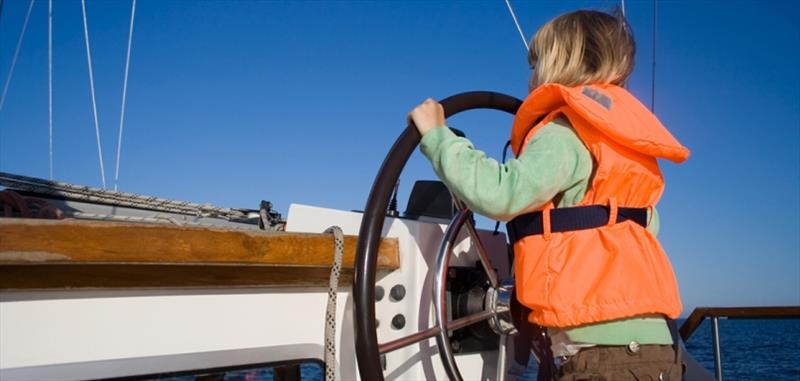
Seven easy ways to boat safely and be kind to nature
by NOAA Fisheries 27 May 2018 21:51 PDT
19 - 25 May 2018

Little sailor on boat with life jacket © NOAA Fisheries
Whether you are boating, fishing or on a sightseeing cruise, NOAA and our partners can help you safely enjoy time on the water and keep the marine environment healthy and protected with these tips:
1. Check the weather forecast. And then check it again
Before going out on the water, check the marine forecast, and stay informed while at sea with a NOAA Weather Radio for marine watches and warnings.
Weather can change quickly on the water. The sudden emergence of dark clouds, rough seas, strong winds or excessive heat can turn a relaxing time on the water into a dangerous situation. Never boat during a thunderstorm: If you can hear thunder, you are close enough to the storm to be struck by lightning (See these lightning facts and safety tips).
Check conditions where you'll be boating at weather buoys in the area to make sure wind and waves are appropriate for your boat, and know the tide predictions to help you navigate safely.
2. Just wear it — your life jacket, that is
Life jackets can be the difference between life and death on the water. It is critical to always wear a properly-fitted life jacket on your own boat and know where they are located, if needed in an emergency, on a sightseeing vessel or cruise ship.
3. Make sure a satellite has your back
In an emergency at sea, NOAA satellites can help. They form part of COSPAS-SARSAT — a satellite network that can detect and locate distress signals from emergency beacons on boats, planes and handheld devices — that helped rescue 275 people in 2017. Before you head out on the water, be sure your boat is equipped with a beacon or carry aboard your own PLB (personal locator beacon.)
4. Use nautical charts to navigate your way
Nautical charts can help you plan and execute your next boating trip. NOAA's Office of Coast Survey maps the seafloor and creates charts that make marine navigation safe and smart.
Recreational boaters can download printable and electronic nautical charts, which can be used to plot destinations and points of interest during a trip. Being aware of underwater features, tidal range, and navigational beacons from an up-to-date nautical chart makes for smooth sailing.
5. Know what's beneath the surface: Avoid sensitive habitat
Nautical charts can also help identify underwater features that represent sensitive habitat for marine life, including submerged grass, coral reefs and oyster beds. Avoiding these areas, which are generally found in shallow water, can keep your boat safe and prevent damage to wildlife habitat.
Tips for boating around wildlife habitat:
- Before anchoring, check the bottom for hazards, and always use a mooring ball if one is available.
- If you run aground, turn off your engine and don't try to motor off any grass beds or reef areas, as this can seriously damage the seafloor — and your boat.
- If you can't raise your engine and float off or free your keel by heeling over a bit, call or use VHF radio to get assistance.
6. Watch out for whales
Thanks to environmental protection efforts, boaters often get to spot whales, turtles and seals while on the water. When watching marine wildlife, it is important to maintain a safe distance, avoid feeding them, keep pets away, and report any marine animals in distress to authorities.
Each region has unique marine life, so you should be familiar with applicable rules and guidance for wildlife viewing before heading out, including when visiting NOAA's National Marine Sanctuaries. If you are a saltwater angler, check out these helpful fishing tips for protecting marine mammals and sea turtles during your next fishing trip.
7. Keep it clean
You can take proactive steps to keep waterways trash free, such as properly securing all trash while onboard and not dumping garbage overboard in any U.S. waters or at sea (Remember: this is illegal). This can harm wildlife who try to ingest or get entangled in the debris tossed into the water.
Setting a good example for other boaters and supporting marinas that follow best environmental practices goes a long way in helping reduce wildlife encounters with trash on the high seas. Tip: If you're trailering, don't forget to wash and dry your boat, and drain bilges after you return to shore to prevent the spread of invasive species.
Put these seven tips into practice during National Safe Boating Week (May 19–25) and anytime you're on the water.